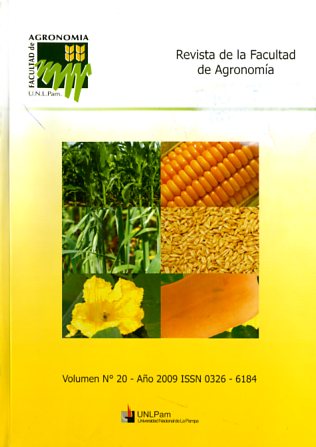Macollamiento y acumulación de materia seca en plantas individuales de avena con distintos momentos de defoliación
Palabras clave:
avena, defoliación temprana, macolla miento, acumulación de materia secaResumen
El objetivo de este estudio fue evaluar, a nivel de planta individual, el efecto de la defoliación sobre la dinámica de macolla miento y de acumulación de materia seca (MS) en avena (Avena byzantina e. Koch.) cv. Milagros INTA. El estudio se realizó durante la temporada de crecimiento de 2007, con semillas de avena sembradas el 4 de Marzo. Los tratamientos consistieron en un testigo (sin defoliación) y dos momentos de inicio de la defoliación y tres fechas de cosecha. El inicio de la defoliación se estableció por el número de hojas expandidas: tres (temprana) y seis (pleno macollaje). El diseño experimental fue completamente al azar con arreglo factorial de los tratamientos (defoliación x fecha de cosecha) y tres repeticiones. Los tratamientos de defoliación se generaron el 5 de Abril (temprana) y el 3 de Mayo (pleno macollaje) con cortes a 5 cm de altura. Las dinámicas de macollamiento y de acumulación de MS se evaluaron en tres momentos: uno a principio de junio, y los otros dos con intervalos de alrededor de 30 días. La densidad de macollos y la acumulación de MS en plantas individuales de avena con defoliación temprana y sin defoliación mostraron un patrón similar (p>O,05). Por el contrario, las plantas con la defoliación en pleno macollaje registraron valores inferiores (p<0,05) para ambas variables. Bajo las condiciones de crecimiento del presente estudio se concluye que la defoliación temprana no promueve el macollamiento ni la acumulación de materia seca, en pleno macollaje ambas variables se deprimen.
Descargas
Citas
Amigone, MA & A.M. Kloster. 1997. Verdeas de invierno. In: N.J. Latimori & A.M. Kloster (eds.). Invernada bovina en zonas mixtas. Agro 2 Córdoba. INTA, Centro Regional Córdoba. pp. 38-56.
Amigone, M.A. & J.C. Tomaso. 2008. Principales características de especies y cultivares de verdeas invernales. http://www.inta.gov.ar (Consultado el23 de Setiembre de 2009).
Briske, D.D. 1991. Developmental morphology and physiology of grasses. en: RK. Heitschmidt & Stuth (eds.). Grazing management: An ecological perspective. Timber Press, Portland, OR, USA, pp. 85-108.
Brizuela, M.A.; A. Alasia & M.S. Cid. 2006. Macollamiento de dos cultivares de avena con y sin defoliación temprana. Rev. Arg. Prod. Anim.26:229-230.
Brizuela, MA & M.S. Cid. 2008. Defoliación temprana y macollamiento en dos cultivares de avena. Rev. Arg. Prod. Anim. 28: 349-353.
Casal, J.J.; VA Deregibus & RA. Sánchez 1985. Variations in tiller dynamics and morphology in Lolium perenne Lam. vegetative and reproductive plants as affected by red/far-red radiation. Ann. Bot 56: 553-559.
Davies, A. 1988. The regrowth of grass swards. en: M.B. Jones & A. Lazenby (eds.). The grass crop. Chapman Hall, London, UK. pp. 85-127.
INDEC. 2002. Encuesta Nacional Agropecuaria 2002. Instituto Nacional de Estadística y Censos. http://www.indec.gov.ar (Consultado el 23 de Setiembre de 2009).
Lemaire G. & D. Chapman. 1996. Tissue flows in grazed plant communities. In: J. Hodgson & A.W. IIlius (eds.). The ecology and management of grazing systems. CAB International, Wallingford, UK. pp. 3-36.
Méndez, D.G. & P. Davies. 2000. Actualización en utilización de verdeas invernales. Publicación Técnica N° 30. Secretaría de Agricultura, Ganadería y Pesca. INTA, EEA General Villegas, 37 p.
Rodríguez Elizagaray, M.; F. Giannitti; E. Odriozola & P. Alvarado. 2007. Manejo alternativo de verdeas de avena: respuesta productiva del forraje al pastoreo precoz. Rev. Arg. Prod. Anim. 27:129-130.
Sonego, M.; D.J. Moot; P.D. Jamieson; RJ. Martin & W.R Scout. 2000. Apical development in oats predicted by leaf stage. Field Crops Res. 65: 79-86.
Descargas
Publicado
Número
Sección
Licencia
La Editorial de la Universidad Nacional de La Pampa (EdUNLPam) exigirá a los/as autores/as la firma del siguiente documento:
La EdUNLPam lleva a cabo la publicación del artículo: (Título del Artículo) en SEMIÁRIDA Rev.Fac.Agron UNLPam ISSN 2362-4337 (impresa) ISSN 2408-4077 (en línea), del cual el/los abajo firmantes son autores de una o más partes. En el mismo acto, el/los autores entregan exclusivamente a la EdUNLPam todos sus derechos protegidos por las leyes de propiedad intelectual que rigen en la Argentina para reproducir, publicar, editar, fijar, comunicar y transmitir públicamente en cualquier formato o medio impreso o electrónico, inclusive internet, el artículo enviado a publicación e incluirlo en índices o bases de datos nacionales e internacionales. A cambio, la EdUNLPam entrega a los autores la autorización para la publicación o reimpresión con ines académicos y educativos en cualquier libro o medio de divulgación, con la sola obligación de citar el artículo original publicado en la EdUNLPam. Cada autor acuerda en que el material provisto a la EdUNLPam es un trabajo original, que no ha sido impreso o publicado en cualquier otro medio con anterioridad y que no vulnera derechos de terceros. El Primer autor tendrá la posibilidad de leer y corregir el artículo ya editado como “prueba de galera”, pero si el autor no devolviera esas correcciones de la prueba de galera dentro del tiempo especificado, el proceso de producción y publicación podrá proseguir sin la aprobación del autor. El/los autor/es no recibirán compensación monetaria de la EdUNLPam por el uso del material contenido en este artículo y asumen la responsabilidad de las opiniones vertidas en él.






.png)



22.png)


.jpg)




.jpg)
10.png)



